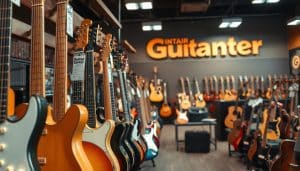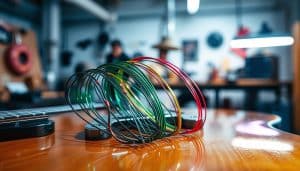Whether you’re a seasoned musician or just starting out on your acoustic guitar journey, finding the perfect pedals to enhance your sound can be a daunting task. Luckily, this ultimate guide is here to help you make the best choice that suits your style and needs. From understanding the different types of pedals available to exploring the top brands and their features, we’ve got you covered. Get ready to take your acoustic guitar playing to the next level as we dive into the exciting world of guitar pedals.
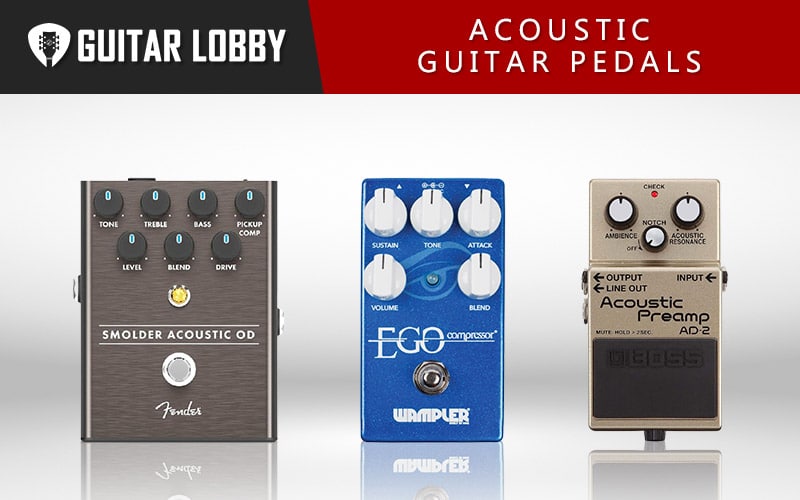
Types of Acoustic Guitar Pedals
Delay Pedals
Delay pedals are one of the most popular types of guitar pedals for both acoustic and electric players. These pedals provide the ability to create repeating echoes of your guitar sound, adding depth and texture to your playing. With a delay pedal, you can control parameters such as delay time, feedback, and mix to achieve different effects, from subtle ambiance to cascading repeats.
Reverb Pedals
Reverb pedals simulate the natural reverberation that occurs in different environments, such as concert halls or rooms. They add spaciousness and depth to your acoustic guitar sound, making it sound like you’re playing in a larger space. Whether you want a subtle room ambience or a lush, cathedral-like reverb, a reverb pedal is an essential tool for adding dimension to your acoustic guitar tone.
Chorus Pedals
Chorus pedals add a shimmering, swirling effect to your guitar sound by creating multiple, slightly detuned versions of your original signal. This creates a thicker, fuller sound that can be especially useful for adding depth and richness to your acoustic guitar tone. Chorus pedals are commonly used in genres such as pop and rock, but they can also add a touch of unique character to any style of music.
Compression Pedals
Compression pedals are often used to even out the dynamics of your guitar signal, resulting in a more consistent and balanced sound. They can enhance sustain and help control excessive peaks in volume, making them popular among acoustic guitarists who want to achieve a smoother and more polished sound. Compression pedals can be particularly useful in live performances, where inconsistent volume levels can be a challenge.
EQ Pedals
EQ (equalizer) pedals allow you to shape and fine-tune the frequency response of your acoustic guitar sound. They come with multiple bands (such as low, mid, and high) that you can adjust to emphasize or cut certain frequencies. This gives you the ability to tailor your tone to match the specific requirements of your acoustic guitar and playing style.
Volume Pedals
Volume pedals give you control over the overall volume level of your acoustic guitar. This can be especially useful for smooth transitions between different song sections or for creating volume swells that add a dramatic effect to your playing. Volume pedals can also be used as an expression pedal to control various parameters on compatible effects pedals.
Tuner Pedals
Tuner pedals are essential for keeping your acoustic guitar in tune. They provide a convenient way to quickly and accurately tune your instrument, whether you’re practicing at home or performing on stage. Tuner pedals often come with features such as built-in displays, true bypass, and multiple tuning modes, making them a must-have tool for every guitarist.
Overdrive/Distortion Pedals
While these types of pedals are more commonly associated with electric guitar, they can also be used effectively with acoustic guitars to add grit, sustain, and a touch of distortion to your sound. Overdrive and distortion pedals can be particularly useful if you’re looking to add some edge or presence to your acoustic guitar playing, especially in genres like blues or rock.
Looper Pedals
Looper pedals are a great tool for solo acoustic guitarists. They allow you to record and loop sections of your playing in real-time, essentially creating an accompaniment for yourself. This can be incredibly useful for creating layered compositions, practicing improvisation, or simply exploring different musical ideas. Looper pedals come with various features, including different loop lengths, undo/redo functions, and built-in rhythm patterns.
Multi-Effects Pedals
Multi-effects pedals are a jack-of-all-trades solution for guitarists who want to experiment with different effects without having to purchase multiple individual pedals. These pedals combine various effects such as delay, reverb, chorus, and more into a single unit, providing a wide range of sonic possibilities. Multi-effects pedals are particularly useful for guitarists who want versatility and convenience in their setup.
Factors to Consider when Choosing Acoustic Guitar Pedals
Sound Quality
When it comes to acoustic guitar pedals, sound quality is of utmost importance. It’s essential to choose pedals that accurately reproduce the natural tone of your acoustic guitar without introducing unwanted noise or coloration. Look for pedals that are known for their transparency and high-quality audio components to ensure that your guitar’s sound remains clear and pristine throughout your signal chain.
Compatibility with Acoustic Guitar
Not all pedals are created equal, and some are better suited for electric guitar rather than acoustic. When choosing pedals for your acoustic guitar, consider whether the pedal is specifically designed for acoustic instruments or has settings and features that can complement the unique characteristics of an acoustic guitar. Acoustic-specific pedals often incorporate features like EQ shaping for acoustic frequencies and impedance matching to ensure optimal performance with your guitar’s pickup system.
Effect Versatility
Think about the range of effects you want to incorporate into your acoustic guitar sound. Some players prefer a minimalist approach with only a few essential pedals, while others like to experiment with a wide range of effects. Consider the specific effects you need or desire, and choose pedals that offer the versatility and flexibility to cover those requirements.
Build Quality and Durability
Acoustic guitar pedals endure a fair amount of wear and tear, whether you’re gigging regularly or not. Look for pedals that are built to withstand the demands of live performances and have a reputation for durability. Sturdy metal enclosures, quality components, and robust footswitches contribute to a pedal’s longevity.
Pedal Size
The size of your pedals can impact how you organize and transport your pedalboard. If you have limited space or prefer a compact setup, consider smaller-sized pedals that won’t take up too much real estate on your pedalboard. However, keep in mind that smaller pedals may have fewer controls or features compared to their larger counterparts.
Power Supply Options
Pedals require power to operate, and it’s important to consider how you’ll power your pedals in your setup. Determine whether you prefer using batteries, AC adapters, or a dedicated multi-output power supply. Some pedals have unique power requirements, so make sure you choose a power supply option that can accommodate all the pedals in your rig.
Price
Price is undoubtedly a significant factor in choosing acoustic guitar pedals. Set a budget range and consider the value you’re getting from a pedal based on its features, build quality, and reputation. While it’s tempting to opt for cheaper options, investing in quality pedals can save you money in the long run by reducing the need for frequent replacements or repairs.
Ease of Use
Pedals should be easy to use and navigate, especially during live performances. Consider the layout and design of the pedal’s controls to ensure they are user-friendly and intuitive. Look for features like LED indicators, clearly labeled knobs and switches, and pedalboard-friendly designs to streamline your workflow on stage.
Connectivity Options
Think about how the pedals will integrate into your existing guitar setup. Consider the input and output options of the pedals, compatibility with different pedalboard configurations, and any specific routing needs. Look for pedals that offer a wide range of connectivity options to ensure seamless integration into your rig.
Additional Features
Some pedals come with additional features that can enhance their versatility or convenience. These may include built-in tuner functions, tap tempo capabilities, MIDI compatibility, expression pedal inputs, or presets for storing and recalling your favorite settings. Consider these extra features to determine if they align with your needs and preferences.

Top Brands in the Acoustic Guitar Pedals Market
TC Electronic
TC Electronic is a renowned brand in the guitar industry, known for its high-quality and innovative pedal designs. They offer a wide range of acoustic guitar pedals, including delay, reverb, chorus, compression, and more. TC Electronic pedals are favored by many professional guitarists for their exceptional sound quality and durable construction.
Boss
Boss is a well-established name in the pedal market and is highly regarded for its reliability and durability. They have a diverse lineup of pedals, catering to all genres and playing styles. Boss pedals are known for their robust build quality and user-friendly controls, making them a popular choice among guitarists of all levels.
Electro-Harmonix
Electro-Harmonix (EHX) has been pushing the boundaries of guitar effects since the 1960s. They offer a wide range of pedals, including iconic models and innovative new designs. EHX pedals are known for their unique and distinctive tones, as well as their roadworthy build quality.
Zoom
Zoom has gained a strong reputation for its versatile and affordable multi-effects processors. They offer a range of products tailored to different guitarists’ needs, including multi-effects pedals with amp modeling, comprehensive effects libraries, and intuitive interfaces. Zoom pedals are popular among players who want a wide range of effects in a compact and budget-friendly package.
MXR
MXR is known for producing high-quality pedals that deliver classic tones and professional-grade sound. They offer a range of pedals, including time-based effects, EQs, and compressors. MXR pedals are favored by many professional guitarists for their exceptional sound quality and roadworthy construction.
Strymon
Strymon is renowned for its premium-quality pedals that deliver studio-quality sound and a wide range of tonal possibilities. Their pedals are known for their exceptional sound quality, extensive control options, and top-notch build quality. Strymon pedals are often considered a top choice for serious players seeking the utmost in sonic versatility.
Eventide
Eventide has a long history of producing high-quality studio effects processors, and their pedals carry the same level of excellence. They offer a range of pedals that deliver professional-grade studio effects, including reverb, delay, and modulation effects. Eventide pedals are highly regarded for their pristine sound quality and extensive tweaking options.
Source Audio
Source Audio is known for its innovative and versatile pedals that combine a wide range of effects in a compact and user-friendly design. Their pedals often feature advanced control options, MIDI compatibility, and deep editing capabilities. Source Audio pedals are popular among experimental guitarists and those seeking to push the boundaries of sonic experimentation.
Line 6
Line 6 is a pioneer in the world of digital modeling and amp simulation. They offer a range of pedals that incorporate the latest technology to provide diverse effects and amp simulations. Line 6 pedals are favored by many guitarists for their versatility, ease of use, and the ability to dial in a wide range of tones.
DigiTech
DigiTech is known for its innovative and feature-rich pedals that cater to a wide range of playing styles. They offer a diverse lineup of pedals, including multi-effects processors, loopers, and specialized effects. DigiTech pedals are appreciated for their unique features, intuitive interfaces, and solid build quality.
Understanding the Different Effects of Acoustic Guitar Pedals
Delay Effect
Delay is one of the most commonly used effects in guitar playing. It creates repeating echoes of your guitar sound, simulating the sound of sound bouncing off walls or objects. The delay effect adds depth, space, and ambience to your playing. It can be used subtly for a touch of reverb-like ambiance or dialed up for rhythmic patterns and cascading echoes.
Reverb Effect
Reverb recreates the natural sound reflections that occur in various environments. It adds an aura of spaciousness and depth to your guitar sound, making it sound like you’re playing in a larger space. The reverb effect is commonly used to give the illusion of playing in concert halls, rooms, or other acoustically unique locations. It can range from subtle and natural to lush and atmospheric.
Chorus Effect
Chorus creates a rich, shimmering effect by creating multiple, slightly detuned versions of your original guitar sound. This adds depth and width to your tone, making it sound bigger and fuller. Chorus is often used in genres like pop and rock to add a touch of lushness and dimension to the guitar sound.
Compression Effect
Compression evens out the dynamics of your guitar signal, making the quieter parts louder and the louder parts softer. It smooths out the overall volume level, resulting in a more consistent and balanced sound. Compression can enhance sustain and control excessive peaks in volume, making your playing sound more polished and controlled.
EQ Effect
EQ allows you to shape and fine-tune the frequency response of your guitar sound. It consists of multiple bands that control specific ranges of frequencies, such as low, mid, and high. EQ pedals help you tailor your tone to match the specific characteristics of your acoustic guitar and compensate for any tonal imbalances. They can boost or cut certain frequencies to sculpt your sound and make it stand out in the mix.
Volume Effect
Volume pedals give you control over the overall volume level of your guitar. This can be used for smooth transitions between different song sections, creating volume swells, or controlling the dynamic range of your playing. A volume pedal can also be used as an expression pedal to control various parameters on compatible effects pedals, giving you a greater level of expressiveness in your playing.
Tuning Effect
Tuner pedals are essential tools for keeping your guitar in tune. They provide a convenient way to quickly and accurately tune your instrument, whether you’re practicing at home, playing live, or recording in the studio. Tuner pedals often feature a built-in display that shows the pitch of each string, making it easy to tune accurately.
Overdrive/Distortion Effect
Overdrive and distortion pedals are more commonly associated with electric guitar, but they can also be used effectively with acoustic guitars. They add grit, sustain, and a touch of distortion to your sound. Overdrive pedals are ideal for adding warmth and presence to your acoustic playing, while distortion pedals can create a more aggressive and saturated tone. Experiment with different settings to find the right amount of drive for your playing style and genre.
Looping Effect
Looper pedals allow you to record and loop sections of your playing in real-time, essentially creating an accompaniment for yourself. This is especially useful for solo acoustic guitarists who want to layer different parts or create complex compositions. Loopers often have features like different loop lengths, undo/redo functions, and built-in rhythm patterns to enhance your looping experience.
Multi-Effect Processing
Multi-effects pedals combine various effects into a single unit, providing a wide range of sonic possibilities. They typically include delay, reverb, modulation, and other effects, as well as amp modeling and presets. Multi-effects pedals are popular among guitarists who want versatility and convenience in their setup. They can be a cost-effective solution, as they eliminate the need for multiple individual pedals.
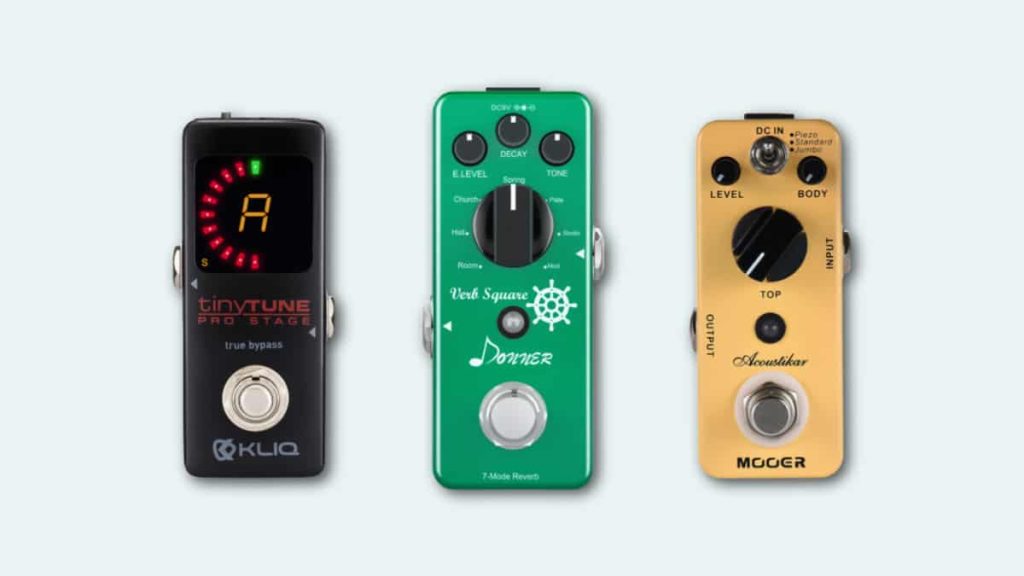
Matching Acoustic Guitar Pedals to Your Playing Style and Genre
Fingerpicking Style
If you primarily play fingerstyle or fingerpicking patterns on your acoustic guitar, you may want to focus on pedals that can enhance the dynamics and tonal balance of your playing. A high-quality compressor can even out volume inconsistencies and help your fingerpicked notes to sustain and bloom. Additionally, a transparent EQ pedal can help shape the frequencies to get the desired tonal characteristics, while a reverb pedal can add a touch of ambiance and depth to your fingerpicking patterns.
Strumming Style
For players who prefer strumming chords on their acoustic guitar, a combination of reverb, chorus, and potentially delay effects can add depth and dimension to the sound. Reverb can create a sense of space, while chorus can enhance the width and fullness of the strummed chords. Delay can be used to add rhythmic patterns to your strumming, creating a textured and lively sound.
Slide Guitar Playing
Slide guitar playing typically benefits from a clean and dynamic tone, with the slide itself creating the primary sonic character. A good compressor pedal can help even out the volume levels and sustain, allowing your slide notes to ring out. Additionally, a high-quality EQ pedal can help shape the frequencies to get the desired tonal balance. Some slide guitar players also experiment with modulation effects like chorus or phaser to create unique textures and sonic variations.
Folk/Indie
Folk and indie genres often call for a more natural and intimate acoustic guitar sound. A combination of reverb, delay, and EQ can help achieve the desired atmospheric and evocative tones. Reverb can add a touch of space and ambiance, while delay can create subtle echoes and repeats. Using an EQ pedal can shape the tonal characteristics to complement the specific song or genre requirements.
Rock/Blues
Rock and blues genres often embrace a more saturated and overdriven guitar tone. Overdrive and distortion pedals can be used to add grit and grind to your acoustic guitar sound, emulating the vintage tones associated with these genres. These pedals work especially well with acoustically-voiced guitars or guitars that are equipped with piezo pickups. Combine them with effects like reverb or delay to add depth and ambience to your rocking blues tones.
Country
Country music typically calls for clean and twangy guitar tones. Compression pedals can help even out the dynamics and sustain the notes, while chorus pedals can add sparkle and depth to your country licks. Some country guitarists also use reverb effects to create that classic “Nashville” sound. Experiment with different combinations of effects to find the perfect tone for your country playing style.
Jazz
Jazz guitar aims for smoothness, clarity, and a warm tone. Compression pedals can help control dynamics, smooth out inconsistencies, and improve sustain. Additionally, EQ pedals can shape the frequencies to achieve a well-balanced and articulate sound. Reverb can be used sparingly to add a touch of room ambiance, while chorus can be used subtly to add dimension to your jazz chords or lines.
Pop
Pop music often requires a versatile and adaptable guitar tone. A combination of reverb and chorus effects can be used to enhance the depth and dimension of your playing, adding a touch of sparkle and shimmer to your sound. EQ pedals can help shape the tonal character to match the specific vibe of your pop songs.
Experimental/Alternative
Experimental and alternative genres embrace sonic exploration and unique textures. A combination of various effects, such as delay, reverb, modulation, and looping, can help create otherworldly sounds and sonic landscapes. Experiment with different pedal combinations and settings to discover your own unique sonic palette within these genres.
Classical
Classical guitar playing typically aims for a clean and natural tone that allows the intricacies of the fingerpicked notes to shine through. While classical guitarists generally prefer to rely on the natural tonal character of their instrument, some may choose to use minimal effects like reverb to add a touch of ambiance to their playing. The focus for classical guitarists is more on instrumental technique and the natural sound of the classical guitar.
Tips for Using Acoustic Guitar Pedals Effectively
Start with Basic Effects
When building your collection of acoustic guitar pedals, it’s a good idea to start with the basics. Experiment with effects like reverb, delay, and chorus, as these can add depth and ambiance to your sound without overwhelming or altering it too dramatically. These effects are considered staples in the world of guitar effects and are versatile enough to be used in various genres and playing styles.
Understand Signal Chain
Understanding your pedal signal chain is crucial for achieving the desired sound and avoiding unwanted tonal changes or noise. Generally, pedals are placed in a specific order, starting with dynamics processors (such as compression) at the beginning of the chain, followed by filters and EQ, modulation effects, time-based effects (like delay and reverb), and finally, the volume pedal. Experiment with different pedal orders to find the sequence that works best for your desired sound.
Experiment with Settings
Don’t be afraid to experiment with the settings on your pedals. Each effect pedal has its own unique tone-shaping possibilities, and tweaking the knobs can yield a wide range of sounds. Spend time experimenting with different combinations and settings to discover new sounds that suit your playing style and genre. Be patient and take the time to explore the subtleties and nuances of each pedal.
Use Pedals to Enhance, Not Mask
Remember that the purpose of using effects pedals is to enhance your playing, not to mask or cover up any shortcomings. Effects should complement and highlight your musical ideas, rather than detract attention from your playing. Use them tastefully and sparingly, focusing on how they can elevate your technique and compositions.
Pay Attention to Volume Levels
Maintaining balanced volume levels is crucial when using effects pedals. Sudden changes in volume can be jarring or overpowering, especially during live performances or recordings. Pay attention to the output levels of each pedal, and if necessary, adjust the volume accordingly to ensure a consistent sound.
Consider Stereo Setups
If you’re looking to expand the sonic possibilities of your acoustic guitar sound, consider incorporating a stereo setup. Stereo effects, such as delay and reverb, can create a rich and immersive soundstage. By utilizing two separate amp setups or stereo pedals, you can achieve a wider and more spacious sound that adds depth and dimension to your playing.
Try Different Combinations
Don’t be afraid to experiment with combining different pedal types to create unique and interesting effects. For example, combining reverb and delay can create a lush and dreamy soundscape, while combining chorus and overdrive can add a touch of vintage warmth and richness. Mixing different pedals often leads to unexpected and creative results, ultimately shaping your own signature sound.
Learn to Tap Tempo
Many delay and modulation pedals come with a tap tempo function that allows you to synchronise the effect timing to the tempo of your playing. Learning to use tap tempo effectively can help you achieve rhythmic and precise delay patterns or modulation effects. Practice tapping in time with your playing to achieve tight and synchronized effects.
Explore Creative Techniques
Acoustic guitar pedals offer a wealth of creative possibilities beyond conventional use. Experiment with unconventional techniques, such as using an EQ pedal for feedback manipulation or using a looper pedal to create layered soundscapes. These creative approaches can help you develop your own unique style and sound.
Fine-tune and Practice
Finding the perfect combination of pedals, settings, and playing technique takes time and practice. Be patient and willing to fine-tune your setup to match your desired sound. Spend time practicing with your pedals to develop a familiarity with their nuances and how they interact with your playing. With consistent practice and experimentation, you’ll gradually develop your own unique approach to using acoustic guitar pedals.
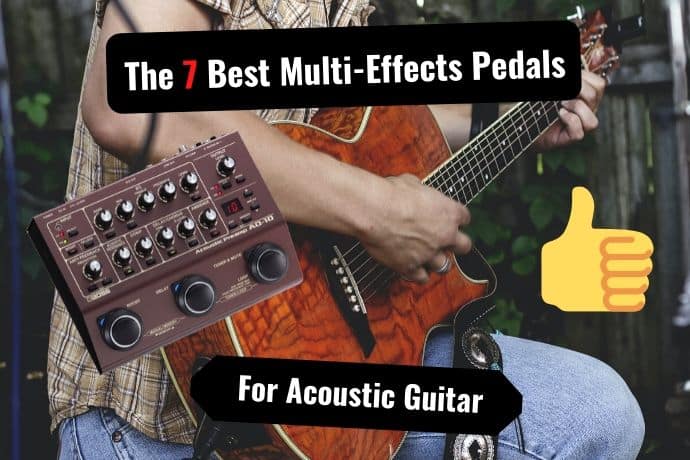
Budget-Friendly Acoustic Guitar Pedal Recommendations
TC Electronic Hall of Fame Mini
The TC Electronic Hall of Fame Mini is a compact reverb pedal that offers a wide range of reverb types in a small footprint. It features TonePrint technology, allowing you to customize and download specific reverb presets from renowned artists. Despite its small size, the Hall of Fame Mini delivers high-quality reverb effects at an affordable price point.
Boss RV-5 Digital Reverb
The Boss RV-5 Digital Reverb is a versatile pedal that provides a wide range of reverb effects, from room and hall to plate and spring reverbs. It features an expression pedal input for real-time control and has a reputation for its reliable build quality. The RV-5 is an excellent choice for guitarists looking for a budget-friendly reverb pedal without compromising on sound quality.
Electro-Harmonix Canyon Delay & Looper
The Electro-Harmonix Canyon Delay & Looper is a compact and feature-packed pedal that offers a wide range of delay effects, from classic tape echo and analog delay to reverse and shimmer effects. It also includes a built-in looper with up to 62 seconds of recording time. The Canyon is known for its versatility, affordability, and the ability to deliver high-quality delay and looping effects in a compact form factor.
Zoom MS-50G MultiStomp
The Zoom MS-50G MultiStomp is a multi-effects pedal that combines a wide range of effects into a single unit. It offers over 100 different effects, including delay, modulation, reverb, and amp modeling. The MS-50G is equipped with a user-friendly interface and allows deep editing capabilities. It is an ideal choice for guitarists on a budget who want versatility and convenience without compromising on sound quality.
MXR M108S Ten Band EQ
The MXR M108S Ten Band EQ is a powerful and transparent EQ pedal that allows precise control over your guitar’s frequency response. It features ten sliders that cover a wide range of frequencies, allowing you to shape your tone with precision. The M108S is built to last with a rugged metal enclosure and provides professional-grade performance at an affordable price.
Strymon BigSky
The Strymon BigSky is a high-end reverb pedal that offers a vast array of studio-quality reverbs in a compact unit. It features twelve different reverb algorithms, including spring, plate, hall, and shimmer. The BigSky is known for its pristine sound quality, detailed controls, and comprehensive editing options. While it falls into a higher price range, it is an investment that will undoubtedly elevate your acoustic guitar sound to new heights.
Eventide H9 Max Harmonizer
The Eventide H9 Max Harmonizer is a versatile multi-effects pedal that combines a wide range of effects, including reverb, delay, chorus, and modulation. It features top-of-the-line sound quality, extensive editing capabilities, and MIDI compatibility. The H9 Max is the ultimate choice for guitarists seeking professional-grade effects in a compact and user-friendly package.
Source Audio Ventris Dual Reverb
The Source Audio Ventris Dual Reverb is a premium reverb pedal that offers studio-quality sounds and a wide range of customizable parameters. It features two independent reverb engines that can be used simultaneously or in parallel. The Ventris is known for its pristine sound quality, advanced editing capabilities, and extensive preset options. While it falls into a higher price range, it is a top choice for musicians who demand the utmost in tonal excellence.
Line 6 HX Stomp
The Line 6 HX Stomp is a compact and powerful multi-effects processor that offers a wide range of amp modeling, effects, and signal routing options. Despite its small size, it packs a punch with over 300 built-in amps, cabs, and effects to choose from. The HX Stomp is ideal for guitarists who want a professional-grade multi-effects unit in a compact and portable format.
DigiTech Trio+ Band Creator + Looper
The DigiTech Trio+ Band Creator + Looper is a unique pedal that combines a drum machine and a bassist with a built-in looper. It analyzes your playing in real-time and generates bass and drum accompaniment, allowing you to create full-band arrangements on the fly. The Trio+ is a valuable tool for solo acoustic guitarists who want to create dynamic and engaging performances.
Intermediate to Professional-Level Acoustic Guitar Pedal Recommendations
TC Electronic Alter Ego V2
The TC Electronic Alter Ego V2 is a vintage-style delay pedal that emulates classic tape echo units and iconic delay sounds. It offers a wide range of delay types, including analog, tape, and reverse. The Alter Ego V2 is known for its warm and authentic tone, intuitive controls, and vintage aesthetics.
Boss DD-500 Digital Delay
The Boss DD-500 Digital Delay is a high-end delay pedal that offers studio-quality delay effects in a compact unit. It features 12 different delay modes, deep editing capabilities, and a built-in phrase looper. The DD-500 is known for its exceptional sound quality, extensive parameter control, and advanced connectivity options.
Electro-Harmonix Stereo Memory Man with Hazarai
The Electro-Harmonix Stereo Memory Man with Hazarai is a versatile delay and looper pedal that offers a wide range of delay effects and looping capabilities. It features multiple delay modes, tap tempo functionality, and up to 30 seconds of loop recording time. The Memory Man is known for its warm and lush analog delay tones, as well as its extensive looping capabilities.
Zoom G5n Multi-Effects Processor
The Zoom G5n Multi-Effects Processor is a feature-packed unit that offers a wide range of amp modeling and effects for guitarists who demand versatility and flexibility. It features realistic amp modeling, over 100 different effects, and deep editing capabilities. The G5n is known for its professional-grade sound quality, intuitive interface, and seamless integration into any guitar setup.
MXR M87 Bass Compressor
The MXR M87 Bass Compressor is a high-quality compressor pedal that is equally suitable for acoustic guitar players. It provides transparent compression that evens out dynamics and enhances sustain. The M87 is known for its studio-quality sound, precise control over compression parameters, and rugged construction.
Strymon Timeline
The Strymon Timeline is a premium-quality delay pedal that offers a wide range of delay sounds and comprehensive editing capabilities. It features twelve different delay types, a built-in looper, MIDI compatibility, and deep parameter control. The Timeline is known for its pristine sound quality, intuitive interface, and top-notch construction.
Eventide Space Reverb
The Eventide Space Reverb is a high-end reverb pedal that offers studio-quality reverbs in a compact unit. It features 12 different reverb algorithms, extensive editing capabilities, and MIDI compatibility. The Space is known for its pristine sound quality, deep and immersive reverbs, and comprehensive control options.
Source Audio Nemesis Delay
The Source Audio Nemesis Delay is a versatile delay pedal that offers a wide range of delay sounds and advanced editing capabilities. It features 24 different delay engines, including classic tape echo, analog, and digital delays. The Nemesis is known for its exceptional sound quality, extensive parameter control, and deep editing capabilities.
Line 6 Helix
The Line 6 Helix is a professional-grade multi-effects processor that offers realistic amp modeling, a wide range of effects, and extensive signal routing options. It features a dual DSP engine for industry-leading sound quality, an intuitive user interface, and a comprehensive selection of amp models and effects. The Helix is favored by many professional guitarists for its performance, versatility, and tonal excellence.
DigiTech Whammy V-01
The DigiTech Whammy V-01 is a classic pitch shifting pedal that allows you to create unique and expressive sounds by shifting the pitch of your guitar. It offers various pitch shifting modes, such as octaves, fifths, and dive bombs, as well as a unique momentary footswitch for real-time pitch-bending effects. The Whammy is known for its innovative and distinctive sound, as well as its responsive and precise control.
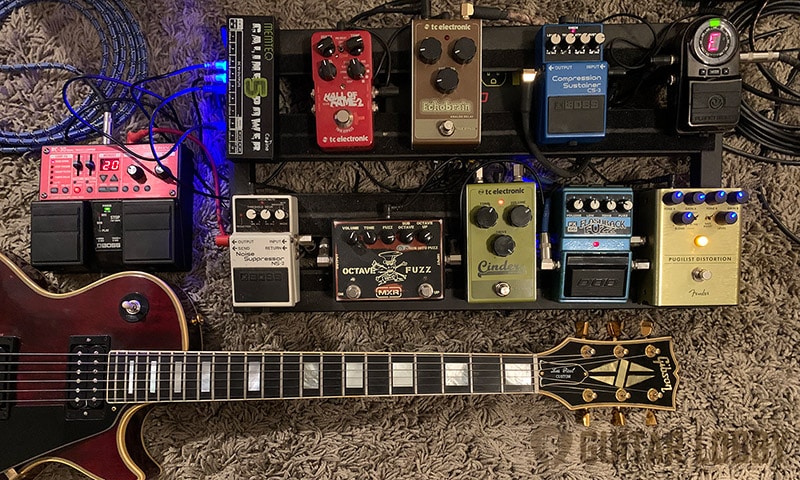
Acoustic Guitar Pedalboard Setup and Cable Management
Choosing the Right Pedalboard
When setting up your acoustic guitar pedalboard, the first step is to choose the right pedalboard size that suits your needs. Consider the number of pedals you want to include and the size of your pedals. Ensure that the pedalboard is wide enough to accommodate your pedals comfortably and provides enough space for cable routing. Look for a sturdy and durable pedalboard that can withstand the demands of live performances and transport.
Placement and Order of Pedals
The placement and order of your pedals can significantly impact your tone and signal chain. Generally, dynamics processors like compressors should be placed at the beginning of the chain to even out your guitar’s dynamics. Filters and EQs can follow to shape the tonal characteristics. Modulation effects such as chorus, phaser, and tremolo can be placed next, while time-based effects like delay and reverb can be placed towards the end of the chain. Experiment with different pedal orders to find the setup that best suits your desired sound.
Power Supply and Cable Management
To power your pedals, consider using a dedicated multi-output power supply. This ensures that your pedals receive clean and consistent power, minimizing noise and interference. Route power cables neatly to avoid tangled cables and potential noise issues. Consider using cable management solutions like cable ties or pedalboard tape to secure and organize cables. Velcro or pedalboard tape can also be used to attach your pedals securely to the pedalboard.
Using Patch Cables
Patch cables are used to connect your pedals together on the pedalboard. Use high-quality patch cables with low capacitance and reliable connectors to ensure a clean signal transmission. Avoid using excessively long patch cables, as they can contribute to signal degradation and unwanted noise. Choose the appropriate cable length for each connection, routing cables efficiently and neatly to maintain a tidy and organized pedalboard setup.
Avoiding Signal Loss and Noise
Signal loss and noise can be introduced into your pedalboard setup due to various factors. To minimize these issues, use high-quality cables, connectors, and power supplies. Place buffered pedals strategically within your chain to maintain a clean and strong signal. Avoid excessively long cable runs, as they can contribute to signal degradation and noise. Regularly check and troubleshoot your pedalboard setup to identify and address any possible sources of signal loss or unwanted noise.
Velcro or Pedalboard Tape
Velcro or pedalboard tape is commonly used to attach pedals to the pedalboard securely. Ensure that the hook and loop sides of the Velcro or pedalboard tape adhere firmly to both the pedal and the pedalboard. This prevents pedals from moving or coming loose during performances or transport. Velcro or pedalboard tape also allows for easy repositioning and rearranging of pedals to accommodate changes in your setup.
Organizing Cables Neatly
Maintaining a tidy and organized cable setup is essential for easy troubleshooting and a clean aesthetic. Use cable ties or hook and loop wraps to bundle and secure cables together. Route cables along the edges or channels of the pedalboard to ensure they are out of the way and less likely to be accidentally unplugged or damaged. Regularly inspect and clean your cables to avoid signal loss or interference caused by dirty or damaged connectors.
Isolating Pedals for Dual Amplifiers
If you’re using dual amplifiers or a stereo setup, it’s important to isolate specific pedals for each amplifier or channel. This ensures that the effect is sent only to the intended amplifier or channel, preventing any unwanted bleed or crosstalk. Use A/B/Y switchers or stereo pedals with separate inputs and outputs to achieve proper isolation and routing between different amplifiers or channels.
Maintaining and Troubleshooting
Regular maintenance and troubleshooting of your pedalboard setup are essential for optimal performance and reliability. Inspect cables and connectors for any signs of wear or damage and replace them as necessary. Clean the contacts of your pedals and cables periodically to remove any dirt or oxide buildup. Troubleshoot any potential issues, such as signal loss or noise, by systematically testing each component and cable in your setup. Keep backup cables and spare pedals handy for quick replacements in case of emergencies.
Conclusion
Choosing the right acoustic guitar pedals is a personal journey that involves understanding your playing style, genre, and tonal preferences. By considering factors like sound quality, compatibility, versatility, build quality, and price, you can make informed decisions when building your pedalboard. Experiment with different pedal combinations and settings to create your unique sound, and use the tips provided to optimize your pedal usage. Whether you’re a beginner exploring different effects or an experienced guitarist looking to refine your tone, acoustic guitar pedals can greatly enhance your playing experience and unlock new sonic possibilities. Remember to have fun with your pedals, and let them inspire you to explore and innovate in your musical journey.



